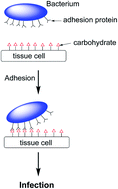Towards bacterial adhesion-based therapeutics and detection methods
Abstract
Bacterial adhesion is an important first step towards bacterial infection and plays a role in colonization, invasion and biofilm formation. Interference with this process is an intriguing approach to fight or prevent bacterial infections, that should lead to less resistance, as selection mechanisms are not triggered. The adhesion process involves in many cases lectin-like adhesion proteins on the bacteria with binding specificity for carbohydrates on the tissue surfaces. Here progress is reported on the development of new carbohydrate-based adhesion inhibitors of the human pathogens uropathogenic E. coli and Pseudomonas aeruginosa and the pig and zoonotic pathogen Streptococcus suis. Both monovalent as well as multivalent carbohydrate ligands have been explored for this purpose. The best systems have been applied in vivo with several promising results. The recognition process responsible for adhesion has also been used for the detection and removal of bacteria by large multivalent molecules or nanoparticles.


 Please wait while we load your content...
Please wait while we load your content...